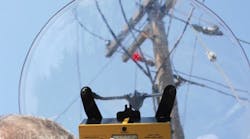Predictive data and advanced data-analytics have been effectively applied in a variety of industries. They are helping to improve the performance of both business processes and individual assets. However, in the electric utility industry, the grid and individual assets are in a dynamic state of change due to constantly changing weather conditions and a number of other external variables that are non-controllable. As a result, predictability and pre-emptive measures have been much more challenging for these utilities.
The good news is that utilities have successfully applied arbor sciences in their vegetation management work to strategically identify the locations of specific plant growth, especially where that puts power lines at imminent risk. With regards to overhead grid assets, identifying pre-fail conditions has been more difficult --- because the majority of the problematic indicators are simply invisible. Even heat signatures that can be detected using infrared cameras require significant time and manpower resources to detect, and these only represent a small fraction of the total outage causation.
Innovation-focused companies are helping to address this problem. One that we should look closely at is a growing private company focused on the Industrial Internet of Things, Exacter Corp. From their headquarters in Columbus, Ohio, U.S., Exacter executives are beginning to change the landscape of predictability in the utility industry. They are doing this by integrating patented, proprietary problem-locating technology with utility Geospatial Information Systems and Outage Management Systems data.
Exacter’s grid assessment database includes hundreds of thousands of miles of deteriorating equipment findings accumulated over 10 years field-work. According to their database, U.S. utilities will have one component showing signs of deterioration for every 7.2 miles of overhead line. What makes things challenging for utilities to address this problem is over those 7.2 miles, there could be 140-150 poles, each with 6-10 components – meaning there is one point of risk for every 1000 assets.
“Finding the one piece of failing equipment out of 1000 is like finding a needle in a haystack,” said Geoffrey Bibo, Exacter’s president. “But, our technology narrows the 150 poles down to just two . . . then the 12-20 components on those two poles down to just the one that is deteriorating. This finding becomes the most important predictive data point a utility has to prevent an outage.”
Unlike traditional methods of finding deteriorating, at-risk assets using visual or IR methods, Exacter does not require users to stop at every pole and do individual inspections of every component. Instead, Exacter’s technology is mounted in vehicles. While driving at posted speed limits, Exacter will capture electrical failure signatures and GPS mark them on a circuit file. To assure accuracy, it will drive each circuit multiple times over a two- to three- week period to confirm the location. Then, once the GPS location is determined, it will send an ultrasonic technology field team to identify the specific pole and component emitting the failure signature. The finding is then photographed and videotaped for confirmation.
“The Exacter process is transformative for utilities for two reasons. Firstly, we eliminate the time and resources required to assess every asset on every pole,” Bibo said. “The second reason has to do with our pre-assessment analytics. We have found that through an analysis of a utility’s OMS data, we can identify 60-70% of the potential risk on the system by assessing just 5-15% of the circuit miles. This statistic has proven true with almost every utility we work with.”
Exacter calls its pre-assessment process ‘predictive circuit targeting.’ It yields a small cluster of circuits that become a manageable bulls-eye for making improvements in the places that will yield the biggest result. Bibo said that “the data in our report is true, conditions-based intelligence on actual assets representing a current threat for an outage. In the world of predictive analytics, our data is the trump card because it identifies the most at-risk assets on the worst performing circuits – and the data is immediately actionable.”
Exacter data is made available through an online, software-as-a-service (SaaS) data portal known as GridTrak. Users can access the findings via the web in data report formats, or in geo-based maps. The data can be sorted and viewed by location, type of deteriorating equipment found, by circuit, or in a variety of other ways. A photograph and video confirmation of the failing equipment are also available on GridTrak. The mapping feature allows utilities to optimize maintenance planning.
In addition, Exacter makes the data available in GIS-compatible formats, kmz files, a PDF formatted work-order report, including photographs and maps of individual findings, plus Excel and CSV files for further analysis by the utility.
“Our deliverable is data,” Bibo said. “But it’s data that only our patented technology provides which makes it extremely valuable. What makes it even more valuable for utilities is that it immediately leverages their existing GIS and asset databases and allows them to drill down into the at-risk condition we have found. Once we give them our data point, the utility can determine things like . . . how many customers will be impacted should an outage occur there, how reliable is the manufacturer of that component, what year was it installed, have they had other problems with that type of component. Or even geocentric issues like: is there critical infrastructure near the finding that could be impacted by an outage, will it impact large industrial or commercial customers, or shut down a school, airport, or military installation. These are the issues that allow management to make data-driven decisions and enable the practice of true predictive analytics.”
The long-term premise of Exacter is that by removing points of risk from the overhead grid, you make the grid healthier and less susceptible to outages. By continuous practice of this process you make the weakest circuits, stronger with fewer points of risk and improve overall system reliability.
“Predictive-based Maintenance using Exacter’s proprietary technology is a common-sense solution,” concluded Bibo. “We believe that a circuit with only one deteriorating component will be less likely to experience an outage than a circuit that has 10 deteriorating components. Furthermore, when storms or major weather events occur, the circuits with fewer assets in weakened condition will be more resilient and will promote faster power restoration.”
Exacter has been collecting data and refining its process since 2007. The company has performed services for over 100 utilities with a client list that includes PG&E, National Grid, AEP, and some of the world’s largest rural cooperatives and municipalities.


